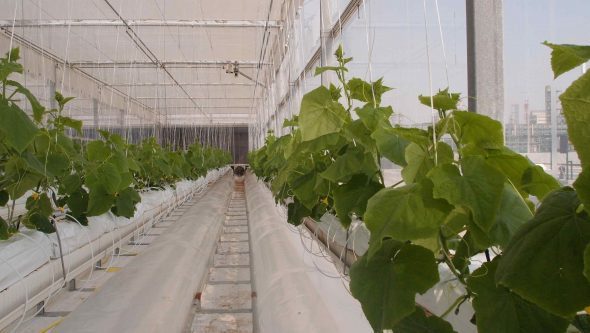Today I ate my first solar cucumber. (It was delicious). Its seed was planted two weeks ago, just before this month’s formal opening of a unique pilot facility in Qatar, in the massive industrial zone that generates the Gulf state’s unbelievable riches. It was grown in a greenhouse cooled by seawater and irrigated by water desalinated by a mechanism powered by solar thermal energy. The electricity to drive various machines and facilities came from solar PV.
Cucumbers have been first product of a pilot project that seeks to harvest three resources of which the world has plenty – the sun, seawater and Co2 – and use them to create food, fresh water, bio-energy and feedstock in regions where they have little, and where it was previously thought impossible to do. Its promoters believe it can be deployed in a massive scale in desert areas that have access to seawater.
The Sahara Forest Project was first unveiled as a concept at the Copenhagen conference in 2009. Among its originators was the UK architect Michael Pawlyn, who was involved in the “Eden Project”, the world biggest greenhouse.
Three years later, it has opened its first facility in Doha, built in conjunction with Norway’s Yara, the world’s largest fertilizer supplier, and Qatari company Qafco, the world’s largest single site producer of urea and ammonia. Those who thought the idea might have been too good to be true, can now go and make a judgment for themselves.
The 1 hectare pilot plant features a small array of solar thermal collectors (parabolic trough), some solar PV, a desalination plant, a saltwater-cooled greenhouse, an algae production facility, and outdoor crops.
But the key, according to CEO Joakim Hauge, is not to see them as a collection of individual technologies, but as a whole. Hoakim says it is a matter of rethinking production systems – and moving from extraction to sustainability, and then to restoration. “The idea is to take the waste product of one technology and use it to create a new resource with another technology,” he says.
The two core ingredients are solar thermal energy and seawater. Solar thermal provides electricity and also heat, which is used to drive an evaporative desalination system for use in irrigation, and to warm the greenhouse.
The saltwater is used to cool the greenhouse through evaporative coolers using a system of recycled corrugated cardboard shaped as a hedge. The same water is then used in a similar system outside, providing shelter and humidity for food and fodder crops.
The seawater is then used for the production of algae, which can then be used for biofuels or feedstock, for growing salt-loving plant species called halophytes, which can also be used for biofuels and feedstock, and finally in salt production.
So far, the facility has produced 23 tonnes of cucumber, but the greenhouse could be used for any type of salad, and crops such as watermelon. Desert grasses and cereal crops are being planted outside, along with the halophytes, and algae production has started. The real test will come in summer, when the facility has to deal with the extreme summer temperatures, and the dust.
After a year, the Safari Forest Project says the next stage will be to move to a larger, 20ha facility, where the idea can be tested at a larger scale. The ultimate goal is to build truly large scale plants that could cover 4,000 hectares. This would include a solar thermal array of around 100MW, 300 hectares of saltwater greenhouses , 2,000 hectares of outdoor revegetation and cereal crops, and 150 hectares of algae cultivation.
 It’s early in the piece to do some modeling, but on rough numbers such a plant would cost around $1.5 to $2 billion, but produce enough electricity (325GWh) and produce – 190,000 tonnes of tomatoes and melons, 30,000 tonnes of fodder crops and 7,500 tonnes of algae oils – each year to make it financially viable.
It’s early in the piece to do some modeling, but on rough numbers such a plant would cost around $1.5 to $2 billion, but produce enough electricity (325GWh) and produce – 190,000 tonnes of tomatoes and melons, 30,000 tonnes of fodder crops and 7,500 tonnes of algae oils – each year to make it financially viable.
The Sahara Forest Project has no doubt there will be demand. In Qatar for instance, the oil and gas rich nation has to import 95 per cent of its food, and desalinate all its water. Food security is a critical issue, and the Qataris are keen for their desert landscape, with desert grasses, to be restored.
Such a plant could, in theory, be located in a remote area, but that would require high levels of solar storage. The practical near-term solution is that it will likely be located close to an electric grid, and in the early years to an industrial source of Co2 – such as the refineries, fertiliser factories, steel plants and LNG plants that surround the pilot. There is, however, the possibility of new technologies that draw down Co2 from the atmosphere to use as a feedstock.









